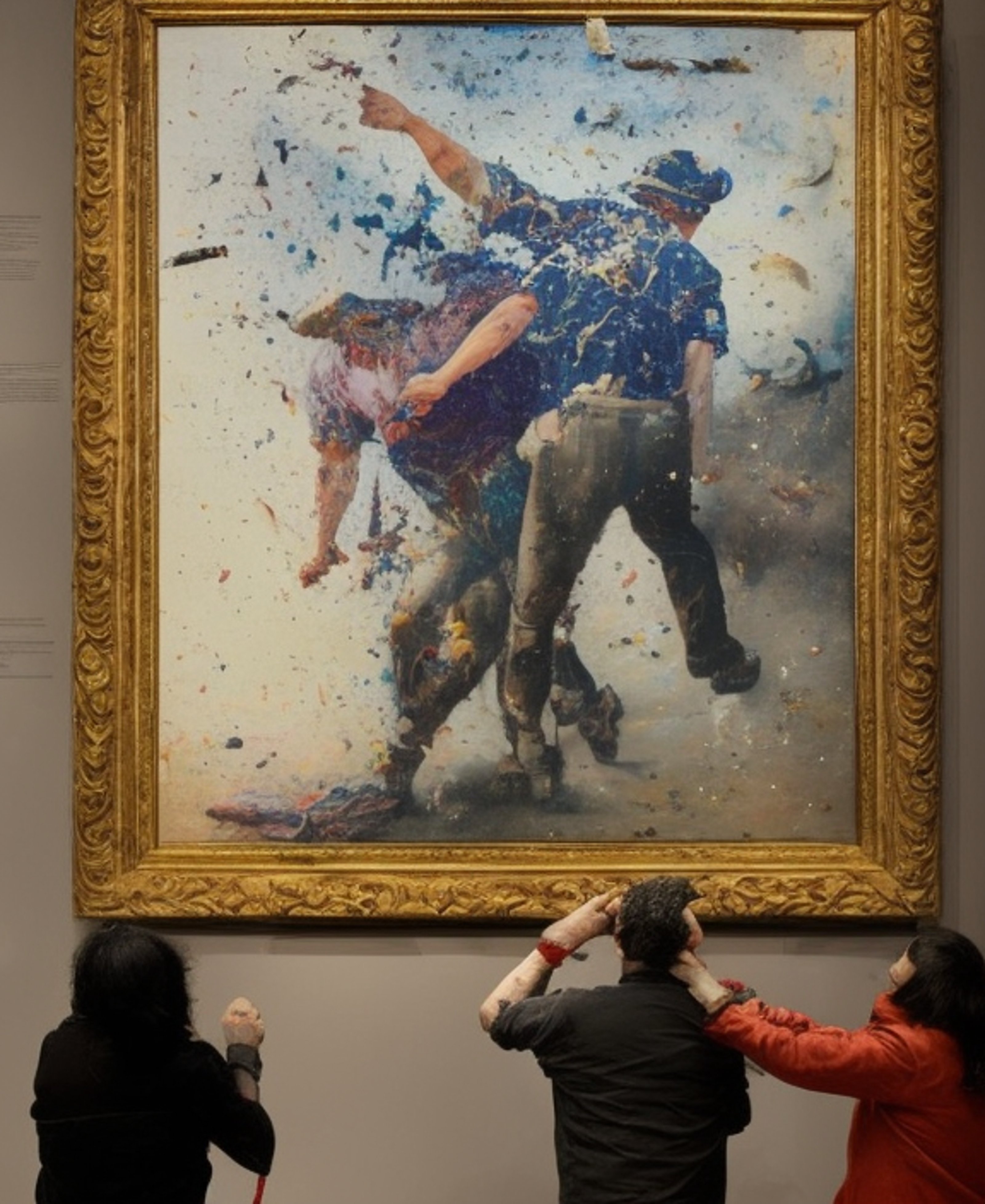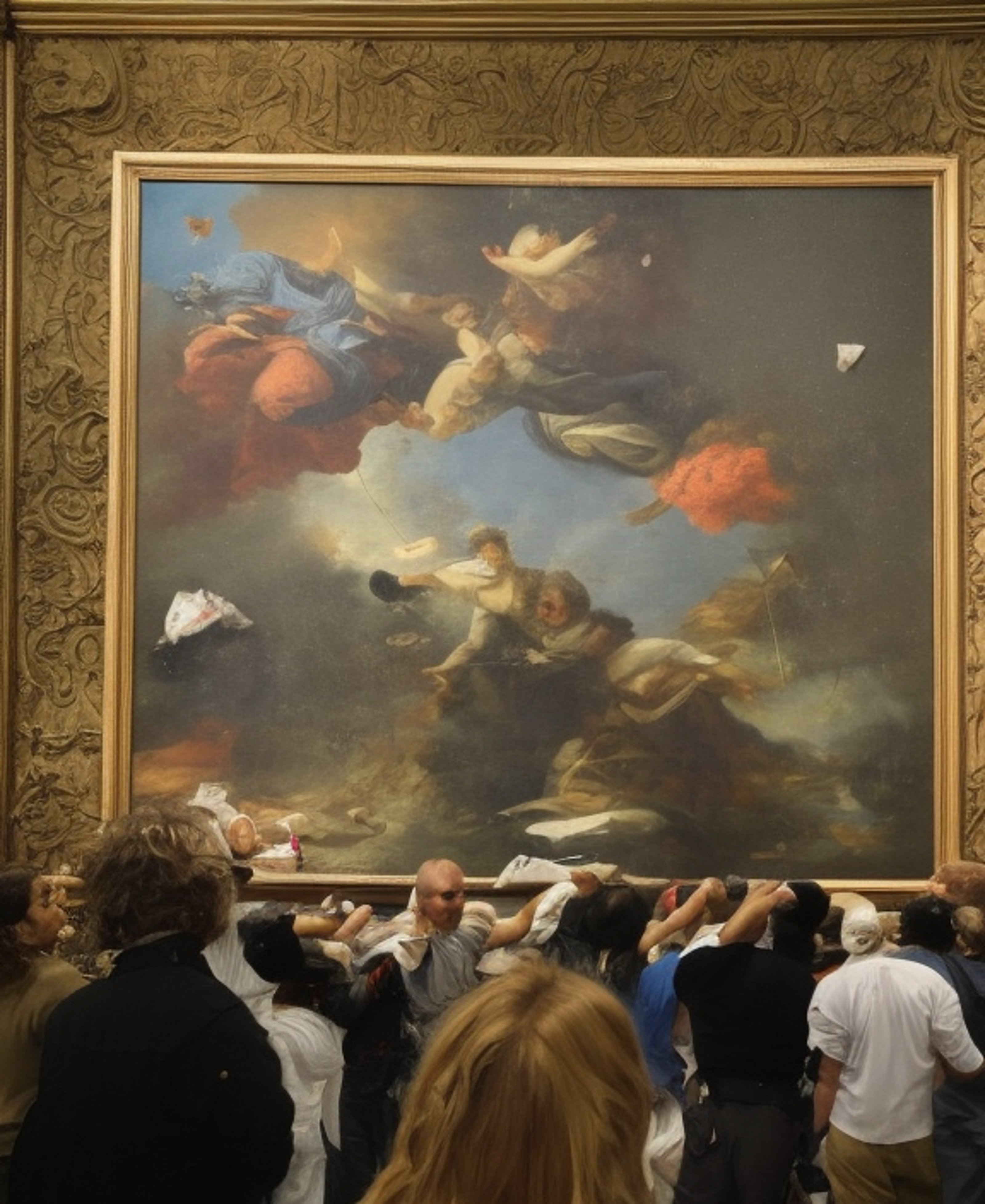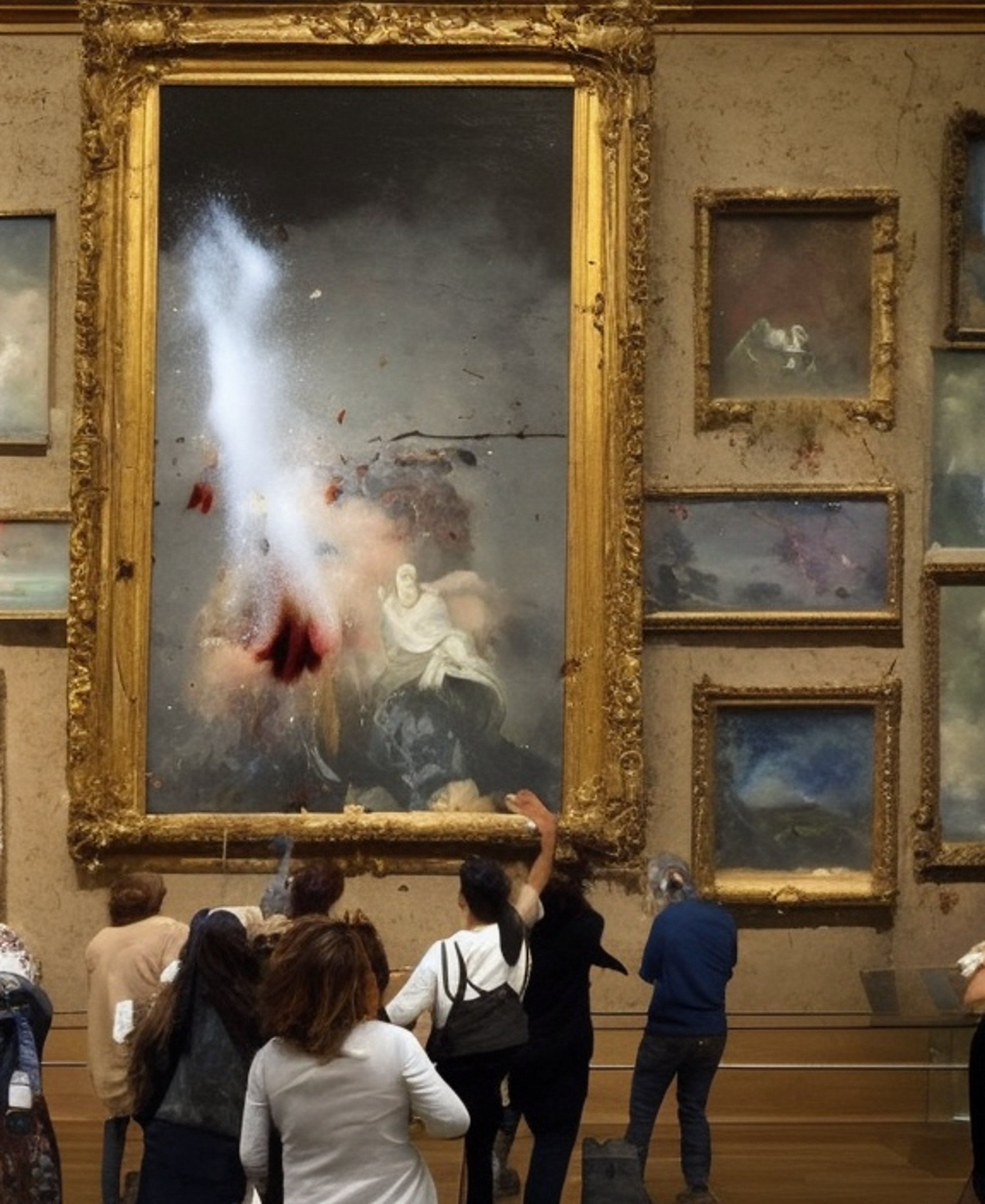In the third installment of Land, Art; a column devoted to the aggressive advance of climate change and the relationship of climate and art, the Collecteurs team investigates the means and methods behind recent climate protests taking place inside of museums - they seem to share two common denominators: famous works of art and pelting food at them. Is this foodfight at the museum justified or is art an innocent victim?
Although art-related protests are nothing new, it is only recently that they have been of major news interest to the general public. Groups such as Just Stop Oil1 or the German offshoot Letzte Generation have become protagonists in the mainstream news cycle with a type of activism uncommon in the artworld.2 These protests use art as a target rather than as the theoretical activism often employed by contemporary artists whose target is awareness through documentary methods. Are these actions working at all? If not, what could be done instead?

The common denominator in recent protests is the use of food thrown at art. The team at Collecteurs asks: why food? Why these specific works of art? One thing is clear, these protests grab attention—but not all copy-cats are treated alike. Two days after Van Gogh’s Sunflowers (1888-89) was hit, the same activists spray-painted an Aston Martin luxury car showroom—but this action did not result in even half as much coverage. Some stunts go under the radar while others flourish in the media. The ones that target familiar masterpieces trend well.
The recent wave of climate protests have a long history with many actions directed towards fossil-fuel groups and banks. On April 29th, 2022, Money Rebellion (an offshoot of Extinction Rebellion) disrupted the annual HSBC conference in central London.3 A dance group interrupted a speech while protestors outside dressed up as bankers cheering to their profits with champagne flutes full of oil. The fashion industry has also been the target of several climate protests; in 2020, the Extinction Rebellion crashed Dior’s runway in Paris; in 2021, they crashed Louis Vuitton. Protestors went down the catwalk holding banners reading “overconsumption = extinction.”4 But these events didn’t produce the outrage that the art protests are garnering.5
While Van Gogh’s Sunflowers is the work that caused the original multi-headline news, it was not the first art protest by the activists. On 5 July 2022, a group of activists spray-painted the wall next to a copy of Leonardo da Vinci’s Last Supper (ca. 1515-20), attributed to Giampietrino, and glued their hands to the frame.6 In the same month protestors glued their hands to the frame of John Constable’s The Hay Wain (1821), and attached their own version of an “apocalyptic future” to the image.7 The Italian group Ultima Generazione similarly glued themselves to Botticelli’s Primavera (1477-82) in the Uffizi, which was mentioned in the first Collecteurs report in this climate and art series.8 But none of these early protests had the media success or social media carnage as tomato soup flung at Van Gogh’s Sunflowers.
The choice of using famous artworks is understandable if the desired effect is media attention. Aligned with a TikTok temporality, and a constant consumption of tailored content, famous or recognisable works of art trend well. This might explain why an exclusive luxury car like Aston Martin, or the specialist runways of fashion houses draw little attention while the hyper-reproduction and commercialized image of Van Gogh’s sunflowers at the National Gallery strikes the viewer personally. It is the very reproduction and circulation of the image that grants authority or “aura” to the original artwork.9 In the case of Van Gogh, the heavy commercialisation makes the artwork familiar, cherished, and relatable as a general object with incontestable cultural value.

Another repeat element of these protests is food. This combination of food and art bothers a lot of people. Activists gluing themselves to works of art does not generate as much of a reaction as throwing soup or potatoes. For a long time, audiences would show their dismay at inferior perofrmances by booing actors offstage or alternatively, by pelting the stage with tomatoes, eggs, or other soft foodstuff.10 Food as a protest method has also been hurled against politicians and institutions. In the times of the Roman Empire, citizens threw food at their emperor in periods of famine; in 2014 Ukrainians threw spaghetti on the Russian consulate in Odessa to protest the invasion of Crimea. Tomato soup also proved a popular weapon against fur coats by PETA activists.11 Eggs also top the chart after American politician Bill Clinton was pelted by eggs in 2001, he afterwards claimed “it’s good for young people to be angry about something.”12
In the case of the recent art protests, food also points to the effects of climate change and the dire scenarios that will unfold in a critical environment where agricultural cycles are disrupted. The protestors ask: what is more important, art or life? They have a point, but do they have the method? Onlookers and commentators send a mixed bag of support and criticism to the performances of these climate activists.13 There are various reasons for this that make us question whether these tactics work or whether they turn people off of climate activism. Afterall, two wrongs don’t make a right. We should live in a world where we can simultaneously preserve publically owned works of art and care for the climate.
One threat is that these actions may alienate existing environmentalists who disagree with their provocative methods. Criticisms also include the privileged status of activists in Europe where it is possible to glue yourself to a Vermeer14 whereas in Mexico alone 54 environmental activists were killed for their reporting and activism in 2021.15 Body politics invariably form part of this kind of performance-based activism, but at the same time point to the failure of traditional protest methods. Many critics ask the activists to shut down oil terminals or target corporations or loggers, but the problem is that they already have—these protests simply have not worked and didn’t make the headlines.16 Successful activists exist, but their actions typically affect local environments and similarly, don’t make headlines.17

We are past the point of raising awareness about climate change; we need actions that are immediate and impactful, and that produce real policy and economic transformation. As long as politicians keep avoiding the subject our prediction is that these protests will increase in frequency. For the art world, change should begin at home, from supporting your local scene of galleries and artists to engaging in digital marketplaces to reduce material transport across the globe. Artists and curators continue to imagine alternatives such as the exhibition “Down to Earth” at Berlin’s Gropius Bau. In it, initiator Thomas Oberender proposed to “Turn off the air conditioning and the lights—open the windows!” Something as simple as opening the blinds to the outside can significantly reduce a museum’s energy expenditure. From Collecteurs, we want to ask our readers, what would you propose as policy for the art world to reduce the industry’s carbon footprint?